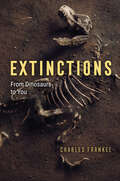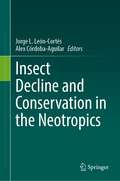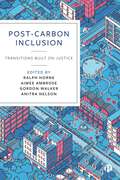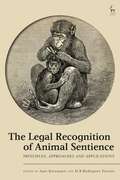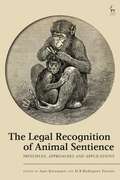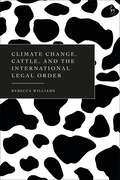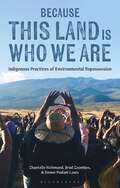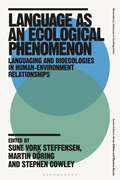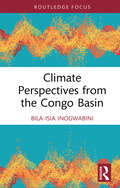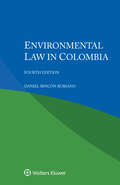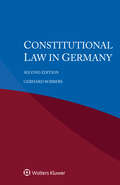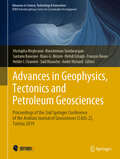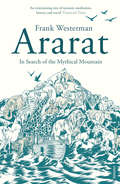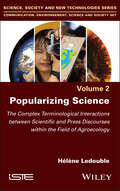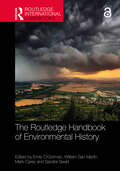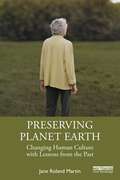- Table View
- List View
Extinctions: From Dinosaurs to You
by Charles FrankelA compelling answer to an important question: Can past mass extinctions teach us how to avoid future planetary disaster? On its face, the story of mass extinction on Earth is one of unavoidable disaster. Asteroid smashes into planet; goodbye dinosaurs. Planetwide crises seem to be beyond our ability to affect or evade. Extinctions argues that geological history tells an instructive story, one that offers important signs for us to consider. When the asteroid struck, Charles Frankel explains, it set off a wave of cataclysms that wore away at the global ecosystem until it all fell apart. What if there had been a way to slow or even turn back these tides? Frankel believes that the answer to this question holds the key to human survival. Human history, from the massacre of Ice Age megafauna to today’s industrial climate change, has brought the planet through another series of cataclysmic events. But the history of mass extinction together with the latest climate research, Frankel maintains, shows us a way out. If we curb our destructive habits, particularly our drive to kill and consume other species, and work instead to conserve what biodiversity remains, the Earth might yet recover. Rather than await decisive disaster, Frankel argues that we must instead take action to reimagine what it means to be human. As he eloquently explains, geological history reminds us that life is not eternal; we can disappear, or we can become something new and continue our evolutionary adventure.
Insect Decline and Conservation in the Neotropics
by Jorge L. León-Cortés Alex Córdoba-AguilarThis book provides for the first time an integrative analysis of the major drivers of decline and threats of insects and related arthropods in the Neotropical region. Thus, it is an urgent first step towards filling an information gap in this region. It identifies the main causes of decline, provides and discusses examples from the better-studied insect faunas to develop and advance principles and practical conservation management for the rich Neotropical insect faunas. The book is aimed at students, naturalists, environmental managers, and others who have training in entomology/insect ecology and can apply the results of surveys of key insect faunas to assess their vulnerability to environmental change and establish guidelines for their conservation.
Post-Carbon Inclusion: Transitions Built on Justice
by Ralph Horne, Aimee Ambrose, Gordon Walker and Anitra NelsonThis collection pays unique attention to the highly challenging problems of addressing inequality within decarbonisation – particularly under-explored aspects, such as high consumption, degrowth approaches and perverse outcomes. Contributors point out means and possibilities of the transition from high carbon inequalities to post-carbon inclusion. They apply a variety of conceptual and methodological approaches in all-inclusive ways to diverse challenges, such as urban heating and retrofitting. Richly illustrated with case studies from the city to the household, this book critically examines ‘just transitions’ to achieve sustainable societies in the future.
Post-Carbon Inclusion: Transitions Built on Justice
by Gordon Walker Ralph Horne Anitra Nelson Aimee AmbroseThis collection pays unique attention to the highly challenging problems of addressing inequality within decarbonisation – particularly under-explored aspects, such as high consumption, degrowth approaches and perverse outcomes. Contributors point out means and possibilities of the transition from high carbon inequalities to post-carbon inclusion. They apply a variety of conceptual and methodological approaches in all-inclusive ways to diverse challenges, such as urban heating and retrofitting. Richly illustrated with case studies from the city to the household, this book critically examines ‘just transitions’ to achieve sustainable societies in the future.
The Legal Recognition of Animal Sentience: Principles, Approaches and Applications
by Jane Kotzmann and MB Rodriguez FerrereThis book explores the movement towards the recognition of animal sentience in the law. It explores some first principles underpinning the recognition of animal sentience, including the nature and scope of sentience provisions, the connection between sentience and empathy, drafting issues, and the relationship between sentience recognition and animal rights. The book highlights the operation of animal sentience provisions in several jurisdictions throughout the world and considers some sector-specific applications and limitations of animal sentience recognition.The first book of its kind, it draws together different perspectives as to what this novel turn in the law might mean and where it might lead. The chapters provide a full picture of what the recognition of animal sentience might entail for humans, animals, and our environment, as well as the experiences of different legal jurisdictions in pursuing recognition of animal sentience.This collection is an essential read for both practitioners and academics alike, as well as any group seeking to advance the interests of non-human animals.
The Legal Recognition of Animal Sentience: Principles, Approaches and Applications
This book explores the movement towards the recognition of animal sentience in the law. It explores some first principles underpinning the recognition of animal sentience, including the nature and scope of sentience provisions, the connection between sentience and empathy, drafting issues, and the relationship between sentience recognition and animal rights. The book highlights the operation of animal sentience provisions in several jurisdictions throughout the world and considers some sector-specific applications and limitations of animal sentience recognition.The first book of its kind, it draws together different perspectives as to what this novel turn in the law might mean and where it might lead. The chapters provide a full picture of what the recognition of animal sentience might entail for humans, animals, and our environment, as well as the experiences of different legal jurisdictions in pursuing recognition of animal sentience.This collection is an essential read for both practitioners and academics alike, as well as any group seeking to advance the interests of non-human animals.
Climate Change, Cattle, and the International Legal Order
by Rebecca WilliamsLivestock food systems need to be rapidly rethought to tackle the global climate crisis. This book examines how climate concerns for the livestock sector are governed in international law and addresses the sector's inclusion (or lack thereof) across the international governance of climate change, agriculture, forests and trade.The book provides a wide-ranging analysis of legal regimes at the international level that affect emissions from cattle (and where relevant, livestock more broadly). On this basis, tensions, interactions, and common themes for livestock emissions mitigation across the international climate change, forestry, agricultural and agri-trade regime are identified. This showcases where productive synergies and damaging tensions have emerged across the cross-cutting nature of livestock governance, enabling goals of fairer and more effective emissions mitigation for the sector to be achieved. In addition to addressing issues such as food security and public health, the book highlights the problem of affluence in reducing cattle emissions from meat consumption. This key insight is significant in terms of tackling future livestock emissions trajectories, particularly in relation to securing climate justice within the agricultural sector and securing equitable and effective livestock solutions. The book is a key text for all those with an interest in the legal governance of climate change and agriculture, adding to the timely debate on the future sustainability of the global diet and the relationship between affluence and climate change.
Climate Change, Cattle, and the International Legal Order
by Rebecca WilliamsLivestock food systems need to be rapidly rethought to tackle the global climate crisis. This book examines how climate concerns for the livestock sector are governed in international law and addresses the sector's inclusion (or lack thereof) across the international governance of climate change, agriculture, forests and trade.The book provides a wide-ranging analysis of legal regimes at the international level that affect emissions from cattle (and where relevant, livestock more broadly). On this basis, tensions, interactions, and common themes for livestock emissions mitigation across the international climate change, forestry, agricultural and agri-trade regime are identified. This showcases where productive synergies and damaging tensions have emerged across the cross-cutting nature of livestock governance, enabling goals of fairer and more effective emissions mitigation for the sector to be achieved. In addition to addressing issues such as food security and public health, the book highlights the problem of affluence in reducing cattle emissions from meat consumption. This key insight is significant in terms of tackling future livestock emissions trajectories, particularly in relation to securing climate justice within the agricultural sector and securing equitable and effective livestock solutions. The book is a key text for all those with an interest in the legal governance of climate change and agriculture, adding to the timely debate on the future sustainability of the global diet and the relationship between affluence and climate change.
Because This Land is Who We Are: Indigenous Practices of Environmental Repossession
by Chantelle RichmondBecause This Land Is Who We Are is an exploration of environmental repossession, told through a collaborative case study approach, and engaging with Indigenous communities in Canada (Anishinaabe), Hawai'i (Kanaka Maoli) and Aotearoa (Maori). The co-authors are all Indigenous scholars, community leaders and activists who are actively engaged in the movements underway in these locations, and able to describe the unique and common strategies of repossession practices taking place in each community. This open access book celebrates Indigenous ways of knowing, relating to and honouring the land, and the authors' contributions emphasize the efforts taking place in their own Indigenous land. Through engagement with these varying cultural imperatives, the wider goal of Because This Land Is Who We Are is to broaden both theoretical and applied concepts of environmental repossession, and to empower any Indigenous community around the world which is struggling to assert its rights to land.The ebook editions of this book are available open access under a CC BY-NC-ND 4.0 licence on bloomsburycollections.com. Open access was funded by Knowledge Unlatched.
Because This Land is Who We Are: Indigenous Practices of Environmental Repossession
by Chantelle RichmondBecause This Land Is Who We Are is an exploration of environmental repossession, told through a collaborative case study approach, and engaging with Indigenous communities in Canada (Anishinaabe), Hawai'i (Kanaka Maoli) and Aotearoa (Maori). The co-authors are all Indigenous scholars, community leaders and activists who are actively engaged in the movements underway in these locations, and able to describe the unique and common strategies of repossession practices taking place in each community. This open access book celebrates Indigenous ways of knowing, relating to and honouring the land, and the authors' contributions emphasize the efforts taking place in their own Indigenous land. Through engagement with these varying cultural imperatives, the wider goal of Because This Land Is Who We Are is to broaden both theoretical and applied concepts of environmental repossession, and to empower any Indigenous community around the world which is struggling to assert its rights to land.The ebook editions of this book are available open access under a CC BY-NC-ND 4.0 licence on bloomsburycollections.com. Open access was funded by Knowledge Unlatched.
Language as an Ecological Phenomenon: Languaging and Bioecologies in Human-Environment Relationships (Bloomsbury Advances in Ecolinguistics)
by Sune Vork Steffensen, Martin Döring and Stephen J. CowleyMoving beyond a more traditional view of language as a discrete sociocultural and cognitive entity that distorts our understanding of surrounding ecologies, this book argues that the starting point for ecolinguistics is an appreciation of language as not just about nature, but of nature. Exploring this conceptual change in the field, the book presents a process view in which language is substituted by languaging, emphasising the bioecologies that we cohabit with numerous other species. It puts forward this perspective by looking at the theoretical considerations behind the understanding of languaging as bioecological, and through examining languaging in various contexts and places. Drawing on examples from across the world, it addresses topics such as climate catastrophes, corporate narratives, questions of ecological leadership, the bioecological implications of the COVID pandemic, and relational landscapes. It also makes use of data from across multiple bioecological settings, including the dairy and agricultural industries.
Language as an Ecological Phenomenon: Languaging and Bioecologies in Human-Environment Relationships (Bloomsbury Advances in Ecolinguistics)
Moving beyond a more traditional view of language as a discrete sociocultural and cognitive entity that distorts our understanding of surrounding ecologies, this book argues that the starting point for ecolinguistics is an appreciation of language as not just about nature, but of nature. Exploring this conceptual change in the field, the book presents a process view in which language is substituted by languaging, emphasising the bioecologies that we cohabit with numerous other species. It puts forward this perspective by looking at the theoretical considerations behind the understanding of languaging as bioecological, and through examining languaging in various contexts and places. Drawing on examples from across the world, it addresses topics such as climate catastrophes, corporate narratives, questions of ecological leadership, the bioecological implications of the COVID pandemic, and relational landscapes. It also makes use of data from across multiple bioecological settings, including the dairy and agricultural industries.
Climate Perspectives from the Congo Basin (Routledge Focus on Environment and Sustainability)
by Bila-Isia InogwabiniThis book considers the global question of climate change from local perspectives in the context of Central Africa.Bila-Isia Inogwabini examines attempts made by the international community to respond to the global challenges posed by climate change in the Congo Basin and highlights that these attempts have so far produced limited results. Abject poverty and the lack of academic, technical, institutional and governance capacities have made it difficult for these solutions to take root in local conditions. Taking a novel perspective, Inogwabini argues that what is needed is not austerity in the use of natural resources but rather increased material affluence for these communities, which will enable individuals to create their own ways to survive through the tides of climate change. He considers factors including social inertia, climate skepticism and lack of political structure and presents a climate change action plan that is targeted at the local level in the Congo Basin.Overall, this volume will be of great interest to students and scholars of climate change, global development and African studies more broadly.
Climate Perspectives from the Congo Basin (Routledge Focus on Environment and Sustainability)
by Bila-Isia InogwabiniThis book considers the global question of climate change from local perspectives in the context of Central Africa.Bila-Isia Inogwabini examines attempts made by the international community to respond to the global challenges posed by climate change in the Congo Basin and highlights that these attempts have so far produced limited results. Abject poverty and the lack of academic, technical, institutional and governance capacities have made it difficult for these solutions to take root in local conditions. Taking a novel perspective, Inogwabini argues that what is needed is not austerity in the use of natural resources but rather increased material affluence for these communities, which will enable individuals to create their own ways to survive through the tides of climate change. He considers factors including social inertia, climate skepticism and lack of political structure and presents a climate change action plan that is targeted at the local level in the Congo Basin.Overall, this volume will be of great interest to students and scholars of climate change, global development and African studies more broadly.
Environmental Law in Colombia
by Daniel Rincón RubianoDerived from the renowned multi-volume International Encyclopaedia of Laws, this book provides ready access to legislation and practice concerning the environment in Colombia. A general introduction covers geographic considerations, political, social and cultural aspects of environmental study, the sources and principles of environmental law, environmental legislation, and the role of public authorities. The main body of the book deals first with laws aimed directly at protecting the environment from pollution in specific areas such as air, water, waste, soil, noise, and radiation. Then, a section on nature and conservation management covers protection of natural and cultural resources such as monuments, landscapes, parks and reserves, wildlife, agriculture, forests, fish, subsoil, and minerals. Further treatment includes the application of zoning and land-use planning, rules on liability, and administrative and judicial remedies to environmental issues. There is also an analysis of the impact of international and regional legislation and treaties on environmental regulation. Its succinct yet scholarly nature, as well as the practical quality of the information it provides, make this book a valuable resource for environmental lawyers handling cases affecting Colombia. Academics and researchers, as well as business investors and the various international organizations in the field, will welcome this very useful guide, and will appreciate its value in the study of comparative environmental law and policy.
Constitutional Law in Germany
by Gerhard RobbersDerived from the renowned multi-volume International Encyclopaedia of Laws, this very useful analysis of constitutional law in Germany provides essential information on the country’s sources of constitutional law, its form of government, and its administrative structure. Lawyers who handle transnational matters will appreciate the clarifications of particular terminology and its application. Throughout the book, the treatment emphasizes the specific points at which constitutional law affects the interpretation of legal rules and procedure. Thorough coverage by a local expert fully describes the political system, the historical background, the role of treaties, legislation, jurisprudence, and administrative regulations. The discussion of the form and structure of government outlines its legal status, the jurisdiction and workings of the central state organs, the subdivisions of the state, its decentralized authorities, and concepts of citizenship. Special issues include the legal position of aliens, foreign relations, taxing and spending powers, emergency laws, the power of the military, and the constitutional relationship between church and state. Details are presented in such a way that readers who are unfamiliar with specific terms and concepts in varying contexts will fully grasp their meaning and significance. Its succinct yet scholarly nature, as well as the practical quality of the information it provides, make this book a valuable time-saving tool for both practising and academic jurists. Lawyers representing parties with interests in Germany will welcome this guide, and academics and researchers will appreciate its value in the study of comparative constitutional law.
Advances in Geophysics, Tectonics and Petroleum Geosciences: Proceedings of the 2nd Springer Conference of the Arabian Journal of Geosciences (CAJG-2), Tunisia 2019 (Advances in Science, Technology & Innovation)
by François Roure Santanu Banerjee Narasimman Sundararajan Mehdi Eshagh Mustapha Meghraoui Helder I. Chaminé Klaus-G. Hinzen André Michard Said MaoucheThis edited book is based on the best papers accepted for presentation during the 2nd Springer Conference of the Arabian Journal of Geosciences (CAJG-2), Tunisia, in 2019. It is of interest to all researchers practicing geophysics/seismology, structural, and petroleum geology.With four sections spanning a large spectrum of geological and geophysical topics with particular reference to Middle East, Mediterranean region, and Africa, this book presents a series of research methods that are nowadays in use for measuring, quantifying, and analyzing several geological domains.It starts with a subsection dedicated to the latest research studies on seismic hazard and risk assessment in Africa presented during the 2019 IGCP-659 meeting organized alongside the CAJG-2. And, it includes new research studies on earthquake geodesy, seismotectonics, archeoseismology and active faulting, well logging methods, geodesy and exploration/theoretical geophysics, petroleum geochemistry, petroleum engineering, structural geology, basement architecture and potential data, tectonics and geodynamics, and thermicity, petroleum, and other georesources. The edited book gives insights into the fundamental questions that address the genesis and evolution of our planet, and this is based on data collection and experimental investigations under physical constitutive laws. These multidisciplinary approaches combined with the geodynamics of tectonic provinces and investigations of potential zones of natural resources (petroleum reservoirs) provide the basis for a more sustainability in the economic development.
Ararat: In Search of the Mythical Mountain
by Frank WestermanMount Ararat in Turkey is where, as biblical tradition has it, Noah's Ark ran aground and God made his covenant with mankind. Now it stands astride the fault-line between religion and science, a geographical, political and cultural crossroads, bound up with the centuries-old history of warfare between different cultures in this region. Frank Westerman takes a pilgrimage from the mountain's foot to its highest slopes, meeting along the way geologists, priests and an expedition in search of the Ark's remains, as well as a Russian astronaut who observes that 'there is something between heaven and earth about which we humans know nothing'. Ararat is a dazzling, highly personal book about science, religion and all that lies between, by one of Europe's most celebrated young writers.
Popularizing Science: The Complex Terminological Interactions between Scientific and Press Discourses within the Field of Agroecology
by Hélène LedoubleMedia coverage of scientific issues is a highly complex process. It involves making a specialized field accessible to the general public, without necessarily disseminating the associated scientific terms or knowledge. The terminological interactions between press discourses and scientific knowledge are presented within the field of agroecology. The analysis of textual data focuses on articles in the general press in French and English, devoted to plant protection practices using natural mechanisms (biological control). This book provides a terminological and cognitive overview of the issues involved in popularizing science in a rapidly expanding field, and of the challenges to be met in the constantly evolving environmental communication sector.
The Routledge Handbook of Environmental History (Routledge International Handbooks)
by Mark Carey Sandra Swart Emily O’Gorman William San MartínThe Routledge Handbook of Environmental History presents a cutting-edge overview of the dynamic and ever-expanding field of environmental history. It addresses recent transformations in the field and responses to shifting scholarly, political, and environmental landscapes.The handbook fully and critically engages with recent exciting changes, contextualizes them within longer-term shifts in the field, and charts potential new directions for study. It focuses on five key areas: Theories and concepts related to changing considerations of social justice, including postcolonial, antiracist, and feminist approaches, and the field’s growing emphasis on multiple human voices and agencies. The roles of non-humans and the more-than-human in the telling of environmental histories, from animals and plants to insects as vectors of disease and the influences of water and ice, the changing theoretical approaches and the influence of concepts in related areas such as animal and discard studies. How changes in theories and concepts are shaping methods in environmental history and shifting approaches to traditional sources like archives and oral histories as well as experiments by practitioners with new methods and sources. Responses to a range of current complex problems, such as climate change, and how environmental historians can best help mitigate and resolve these problems. Diverse ways in which environmental historians disseminate their research within and beyond academia, including new modes of research dissemination, teaching, and engagements with stakeholders and the policy arena. This is an important resource for environmental historians, researchers and students in the related fields of political ecology, environmental studies, natural resources management and environmental planning.Chapters 9, 10 and 26 of this book are freely available as a downloadable Open Access PDF at http://www.taylorfrancis.com under a Creative Commons Attribution-Non Commercial-No Derivatives (CC-BY-NC-ND) 4.0 license.
Preserving Planet Earth: Changing Human Culture with Lessons from the Past
by Jane Roland MartinThis book encourages readers to acknowledge humanity’s contribution to the environmental crisis, proposing a way forward by exploring the power of ordinary people to bring about large-scale cultural change.Is it possible for humankind to change its ways and shed the belief that the planet is ours to do with as we like? Internationally acclaimed philosopher of education Jane Roland Martin argues that "humancentrism" is a learned affair, and what is learned can be unlearned. Turning to the past to see how large-scale cultural change has occurred, she discovers a pattern in the achievements of such historical luminaries as Martin Luther, Mahatma Gandhi, Rosa Parks and Greta Thunberg that we too can follow. Drawing on history, philosophy, and literature as well as the natural and social sciences and hoping to mobilize readers to effective action, Martin employs an accessible and powerful rhetoric, with each chapter beginning with a scene from history written in dialogue form.This book calls on young and old to avert a looming tragedy of Aristotelian proportions--the demise of the “Mother Nature” that made it possible for our species to flourish. Thoroughly interdisciplinary in its approach, it will appeal to students and teachers as well as general readers interested in environmental studies, philosophy, and education.
Preserving Planet Earth: Changing Human Culture with Lessons from the Past
by Jane Roland MartinThis book encourages readers to acknowledge humanity’s contribution to the environmental crisis, proposing a way forward by exploring the power of ordinary people to bring about large-scale cultural change.Is it possible for humankind to change its ways and shed the belief that the planet is ours to do with as we like? Internationally acclaimed philosopher of education Jane Roland Martin argues that "humancentrism" is a learned affair, and what is learned can be unlearned. Turning to the past to see how large-scale cultural change has occurred, she discovers a pattern in the achievements of such historical luminaries as Martin Luther, Mahatma Gandhi, Rosa Parks and Greta Thunberg that we too can follow. Drawing on history, philosophy, and literature as well as the natural and social sciences and hoping to mobilize readers to effective action, Martin employs an accessible and powerful rhetoric, with each chapter beginning with a scene from history written in dialogue form.This book calls on young and old to avert a looming tragedy of Aristotelian proportions--the demise of the “Mother Nature” that made it possible for our species to flourish. Thoroughly interdisciplinary in its approach, it will appeal to students and teachers as well as general readers interested in environmental studies, philosophy, and education.
Carbon-Neutral Architectural Design
by Pablo M. La RocheThe energy used to build and operate buildings is a significant source of greenhouse gas emissions. While it is possible to reduce emissions through low-carbon design, many architects are not trained to do this. Filling an urgent need for a design reference in this emerging field, this book describes how to reduce building-related greenhouse gas emissions through appropriate design techniques. It presents strategies to achieve CO2 reductions, with an emphasis on control of energy flows through the building envelope and passive cooling and heating strategies. This new, revised edition is updated throughout and includes a new section on embodied carbon and new chapters on daylighting and nature-based cooling.Features: Adds new chapters on daylighting and nature-based cooling with numerous updates throughout the rest of the chapters Presents strategies, illustrated with examples, for new construction and existing buildings to reduce energy consumption and reduce emissions Explains the origins of CO2 emissions associated with the operation and fabrication of buildings: supplying water, disposing of waste from the building, and proposes strategies to reduce them Covers carbon calculations, thermal comfort, indigenous technology, climate‑responsive design, passive cooling and heating, solar design, air flow analysis, daylighting, building simulation and microclimate design with abundant examples Examines siting/location to design buildings that adapt and mitigate their effect on climate change
Carbon-Neutral Architectural Design
by Pablo M. La RocheThe energy used to build and operate buildings is a significant source of greenhouse gas emissions. While it is possible to reduce emissions through low-carbon design, many architects are not trained to do this. Filling an urgent need for a design reference in this emerging field, this book describes how to reduce building-related greenhouse gas emissions through appropriate design techniques. It presents strategies to achieve CO2 reductions, with an emphasis on control of energy flows through the building envelope and passive cooling and heating strategies. This new, revised edition is updated throughout and includes a new section on embodied carbon and new chapters on daylighting and nature-based cooling.Features: Adds new chapters on daylighting and nature-based cooling with numerous updates throughout the rest of the chapters Presents strategies, illustrated with examples, for new construction and existing buildings to reduce energy consumption and reduce emissions Explains the origins of CO2 emissions associated with the operation and fabrication of buildings: supplying water, disposing of waste from the building, and proposes strategies to reduce them Covers carbon calculations, thermal comfort, indigenous technology, climate‑responsive design, passive cooling and heating, solar design, air flow analysis, daylighting, building simulation and microclimate design with abundant examples Examines siting/location to design buildings that adapt and mitigate their effect on climate change
Land Carbon Cycle Modeling: Matrix Approach, Data Assimilation, Ecological Forecasting, and Machine Learning
Carbon moves through the atmosphere, through the oceans, onto land, and into ecosystems. This cycling has a large effect on climate – changing geographic patterns of rainfall and the frequency of extreme weather – and is altered as the use of fossil fuels adds carbon to the cycle. The dynamics of this global carbon cycling are largely predicted over broad spatial scales and long periods of time by Earth system models. This book addresses the crucial question of how to assess, evaluate, and estimate the potential impact of the additional carbon to the land carbon cycle. The contributors describe a set of new approaches to land carbon cycle modeling for better exploring ecological questions regarding changes in carbon cycling; employing data assimilation techniques for model improvement; doing real- or near-time ecological forecasting for decision support; and combining newly available machine learning techniques with process-based models to improve prediction of the land carbon cycle under climate change. This new edition includes seven new chapters: machine learning and its applications to carbon cycle research (five chapters); principles underlying carbon dioxide removal from the atmosphere, contemporary active research and management issues (one chapter); and community infrastructure for ecological forecasting (one chapter).Key Features Helps readers understand, implement, and criticize land carbon cycle models Offers a new theoretical framework to understand transient dynamics of the land carbon cycle Describes a suite of modeling skills – matrix approach to represent land carbon, nitrogen, and phosphorus cycles; data assimilation and machine learning to improve parameterization; and workflow systems to facilitate ecological forecasting Introduces a new set of techniques, such as semi-analytic spin-up (SASU), unified diagnostic system with a 1-3-5 scheme, traceability analysis, and benchmark analysis, and PROcess-guided machine learning and DAta-driven modeling (PRODA) for model evaluation and improvement Reorganized from the first edition with seven new chapters added Strives to balance theoretical considerations, technical details, and applications of ecosystem modeling for research, assessment, and crucial decision-making
